Information injection-pump assembly
BOSCH
9 400 619 548
9400619548
ZEXEL
101491-9720
1014919720
MAZDA
SLTP13800
sltp13800

Rating:
Service parts 101491-9720 INJECTION-PUMP ASSEMBLY:
1.
_
4.
SUPPLY PUMP
6.
COUPLING PLATE
7.
COUPLING PLATE
8.
_
9.
_
11.
Nozzle and Holder
SL50 13 H50A
12.
Open Pre:MPa(Kqf/cm2)
16.7{170}
15.
NOZZLE SET
Cross reference number
BOSCH
9 400 619 548
9400619548
ZEXEL
101491-9720
1014919720
MAZDA
SLTP13800
sltp13800
Zexel num
Bosch num
Firm num
Name
Calibration Data:
Adjustment conditions
Test oil
1404 Test oil ISO4113 or {SAEJ967d}
1404 Test oil ISO4113 or {SAEJ967d}
Test oil temperature
degC
40
40
45
Nozzle and nozzle holder
105780-8140
Bosch type code
EF8511/9A
Nozzle
105780-0000
Bosch type code
DN12SD12T
Nozzle holder
105780-2080
Bosch type code
EF8511/9
Opening pressure
MPa
17.2
Opening pressure
kgf/cm2
175
Injection pipe
Outer diameter - inner diameter - length (mm) mm 6-2-600
Outer diameter - inner diameter - length (mm) mm 6-2-600
Overflow valve
131424-3420
Overflow valve opening pressure
kPa
255
221
289
Overflow valve opening pressure
kgf/cm2
2.6
2.25
2.95
Tester oil delivery pressure
kPa
157
157
157
Tester oil delivery pressure
kgf/cm2
1.6
1.6
1.6
Direction of rotation (viewed from drive side)
Right R
Right R
Injection timing adjustment
Direction of rotation (viewed from drive side)
Right R
Right R
Injection order
1-3-4-2
Pre-stroke
mm
3.2
3.15
3.25
Beginning of injection position
Drive side NO.1
Drive side NO.1
Difference between angles 1
Cal 1-3 deg. 90 89.5 90.5
Cal 1-3 deg. 90 89.5 90.5
Difference between angles 2
Cal 1-4 deg. 180 179.5 180.5
Cal 1-4 deg. 180 179.5 180.5
Difference between angles 3
Cyl.1-2 deg. 270 269.5 270.5
Cyl.1-2 deg. 270 269.5 270.5
Injection quantity adjustment
Adjusting point
-
Rack position
11.8
Pump speed
r/min
1000
1000
1000
Average injection quantity
mm3/st.
59.3
58.8
59.8
Max. variation between cylinders
%
0
-2.5
2.5
Basic
*
Fixing the rack
*
Standard for adjustment of the maximum variation between cylinders
*
Injection quantity adjustment_02
Adjusting point
-
Rack position
10.1+-0.
5
Pump speed
r/min
340
340
340
Average injection quantity
mm3/st.
10
8
12
Max. variation between cylinders
%
0
-14
14
Fixing the rack
*
Standard for adjustment of the maximum variation between cylinders
*
Remarks
Adjust only variation between cylinders; adjust governor according to governor specifications.
Adjust only variation between cylinders; adjust governor according to governor specifications.
Injection quantity adjustment_03
Adjusting point
A
Rack position
R1(11.8)
Pump speed
r/min
1000
1000
1000
Average injection quantity
mm3/st.
59.3
58.8
59.8
Basic
*
Fixing the lever
*
Injection quantity adjustment_04
Adjusting point
B
Rack position
R1+0.3
Pump speed
r/min
1600
1600
1600
Average injection quantity
mm3/st.
72.4
68.4
76.4
Fixing the lever
*
Injection quantity adjustment_05
Adjusting point
C
Rack position
R1-0.75
Pump speed
r/min
750
750
750
Average injection quantity
mm3/st.
41.1
37.1
45.1
Fixing the lever
*
Injection quantity adjustment_06
Adjusting point
I
Rack position
-
Pump speed
r/min
100
100
100
Average injection quantity
mm3/st.
75
70
85
Fixing the lever
*
Rack limit
*
Timer adjustment
Pump speed
r/min
(1500)+-
25
Advance angle
deg.
0
0
0
Remarks
Start
Start
Timer adjustment_02
Pump speed
r/min
(1750)
Advance angle
deg.
3
2.7
3.3
Remarks
Finish
Finish
Test data Ex:
Governor adjustment
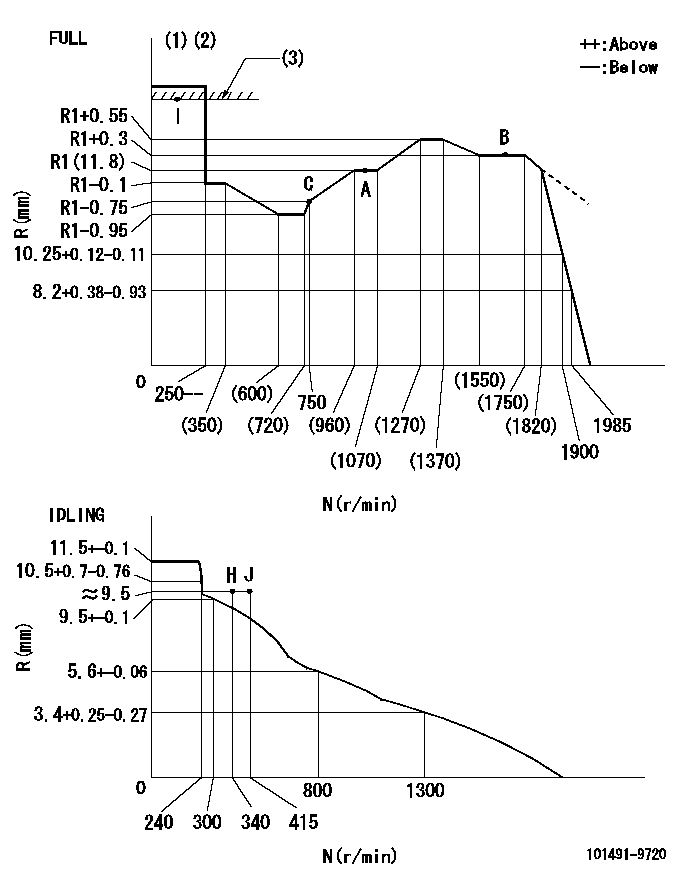
N:Pump speed
R:Rack position (mm)
(1)Torque cam stamping: T1
(2)Tolerance for racks not indicated: +-0.05mm.
(3)RACK LIMIT
----------
T1=D21
----------
----------
T1=D21
----------
Speed control lever angle
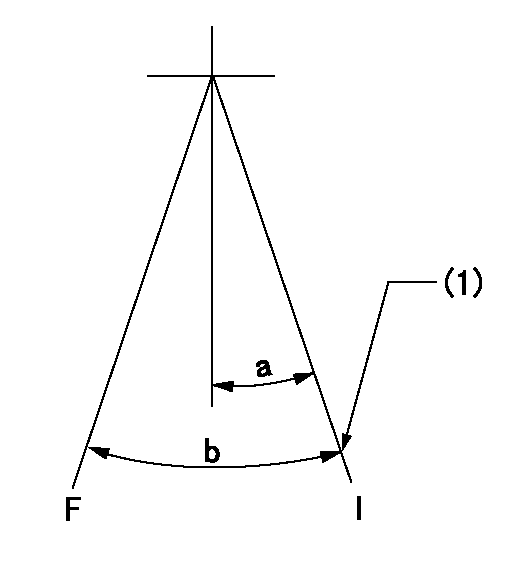
F:Full speed
I:Idle
(1)Stopper bolt set position 'H'
----------
----------
a=20deg+-5deg b=43deg+-3deg
----------
----------
a=20deg+-5deg b=43deg+-3deg
Stop lever angle
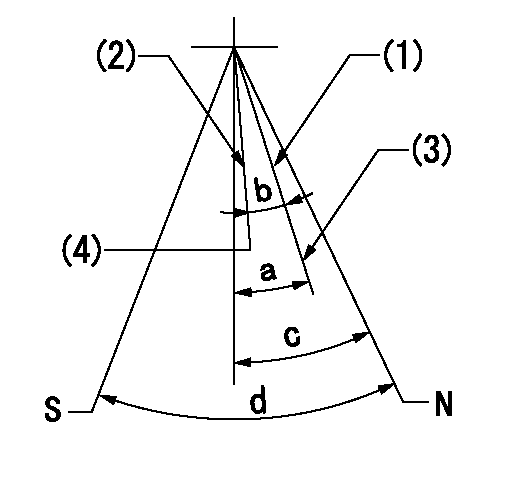
N:Pump normal
S:Stop the pump.
(1)Normal
(2)Stop
(3)Set the normal set bolt.
(4)Set the speed to aa using the idle lever and then confirm non-injection.
----------
aa=340r/min
----------
a=(15deg)+-5deg b=(13.5deg) c=23deg+-5deg d=40deg+-5deg
----------
aa=340r/min
----------
a=(15deg)+-5deg b=(13.5deg) c=23deg+-5deg d=40deg+-5deg
0000001501 LEVER
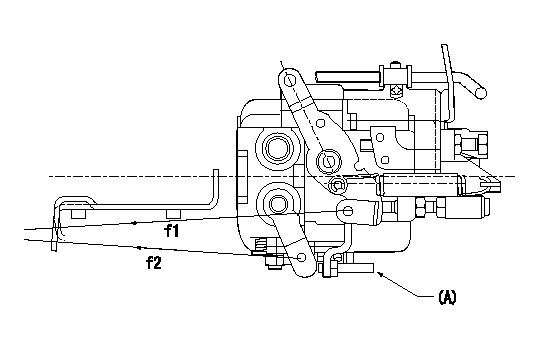
f1:Direction for pulling the speed lever
f2:Direction for pulling the stop lever
Stop lever's normal position setting method
1. (1) Push in the set bolt (A) until the rack starts to move.
(2)Return the bolt N1 turns from that position and set.
2. Rack with limiter
(1)Return the bolt N1 turns from the rack limit position and set.
----------
N1=1.5
----------
----------
N1=1.5
----------
0000001601 ACS
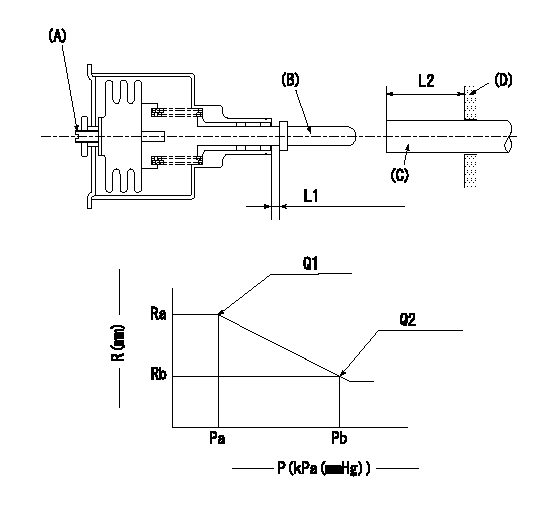
(A) Set screw
(B) Push rod 1
(C) Push rod 2
(D) Cover
1. Aneroid compensator unit adjustment
(1)Select the push rod 2 to obtain L2.
(2)Screw in (A) to obtain L1.
2. Adjustment when mounting the governor.
(1)Set the speed of the pump to N1 r/min and fix the control lever at the full set position.
(2)Screw in the aneroid compensator to obtain the performance shown in the graph above.
(3)As there is hysterisis, measure when the absolute pressure drops.
(4)Hysterisis must not exceed rack position = h1.
----------
N1=1000r/min L1=(1.5)mm L2=11+-0.5mm h1=-
----------
Ra=R1(11.8)mm Rb=(R1-0.4)mm Pa=88.6+-2.7kPa(665+-20mmHg) Pb=79.4+-0.7kPa(596+-5mmHg) Q1=59.3+-0.5cm3/1000st Q2=51.9+-1cm3/1000st
----------
N1=1000r/min L1=(1.5)mm L2=11+-0.5mm h1=-
----------
Ra=R1(11.8)mm Rb=(R1-0.4)mm Pa=88.6+-2.7kPa(665+-20mmHg) Pb=79.4+-0.7kPa(596+-5mmHg) Q1=59.3+-0.5cm3/1000st Q2=51.9+-1cm3/1000st
Timing setting

(1)Pump vertical direction
(2)Position of gear mark 'CC' at No 1 cylinder's beginning of injection
(3)-
(4)-
----------
----------
a=(130deg)
----------
----------
a=(130deg)
Information:
(3) Check the unit seals installed in the impeller and water pump case for damage and wear. If defects are evident, or when water leaks during operation, replace the unit seals with new ones. Whenever the unit seal is removed, it must be replaced with a new one. (4) Using a gear puller or press, remove the ball bearings. Do not remove the ball bearing except for replacement. (5) When the impeller and flange are removed from the water pump shaft, it may result in insufficient interference. If the interference is below the specification even reassembly is two times or less they must be replaced with new ones.Reassembly
5.3 Thermostat
Removal and installation
Do not remove the thermostat case and front hanger unless they cause water leak or other defects.Inspection
Agitate water in the container with the stirrer to obtain uniform temperature. For the inspection, use the following procedures. (1) Slowly heat water to the thermostat valve opening temperature. Keep this condition for about five minutes and make sure that the valve is open.(2) Raise the water temperature up to 90°C. Keep the condition for five minutes and measure the lift of pellet.(3) Lower temperature down to 65°C or below and ensure that the valve is fully closed. If the thermostat is found defective in any of the above items, replace it with a new one. Support the thermostat so that the heat source will not directly heat the thermostat.5.4 Radiator
Inspection (1) Using a copper wire or similar device, remove dirt, mud, and bugs from the front of radiator core with care to prevent damage to tubings. (2) Connect a hose to one of the radiator ports, cap the other port, and immerse the radiator into water. Using a radiator cap tester, force the compressed air under the specified inspection pressure from the hose end to check for leaks.If there is a leak, resolder the point of leakage or replace the radiator.(3) Inspection of Radiator Cap Check the spring tension and sealing condition of the pressure valve and vent valve. If defective, replace. Check the pressure valve opening pressure, using a radiator cap tester.5.5 Inspection and Adjustment of V-belt Tension
Adjust the belt tension to obtain the specified belt deflection when the center of each belt is pressed with a force of approximately 98 N (10 kgf). 1. A slack belt can be a cause of overheating and undercharge.2. An excessively tight belt may result in damaged bearings and belts.3. When paired belts are to be replaced, be sure to replace both.5.6 Cleaning of Cooling System
If the radiator is used for a long time, rust, scale, mud, etc. are deposited inside, resulting in overheat. Clean the cooling system with city water by using the following procedures.The city water to be used should have the following properties.Required properties of city water 1. Use a cleaning solution if the radiator is seriously obstructed or coolant is seriously contaminated.2. When the cooling system is cleaned or washed with water, make sure that the coolant temperature is
5.3 Thermostat
Removal and installation
Do not remove the thermostat case and front hanger unless they cause water leak or other defects.Inspection
Agitate water in the container with the stirrer to obtain uniform temperature. For the inspection, use the following procedures. (1) Slowly heat water to the thermostat valve opening temperature. Keep this condition for about five minutes and make sure that the valve is open.(2) Raise the water temperature up to 90°C. Keep the condition for five minutes and measure the lift of pellet.(3) Lower temperature down to 65°C or below and ensure that the valve is fully closed. If the thermostat is found defective in any of the above items, replace it with a new one. Support the thermostat so that the heat source will not directly heat the thermostat.5.4 Radiator
Inspection (1) Using a copper wire or similar device, remove dirt, mud, and bugs from the front of radiator core with care to prevent damage to tubings. (2) Connect a hose to one of the radiator ports, cap the other port, and immerse the radiator into water. Using a radiator cap tester, force the compressed air under the specified inspection pressure from the hose end to check for leaks.If there is a leak, resolder the point of leakage or replace the radiator.(3) Inspection of Radiator Cap Check the spring tension and sealing condition of the pressure valve and vent valve. If defective, replace. Check the pressure valve opening pressure, using a radiator cap tester.5.5 Inspection and Adjustment of V-belt Tension
Adjust the belt tension to obtain the specified belt deflection when the center of each belt is pressed with a force of approximately 98 N (10 kgf). 1. A slack belt can be a cause of overheating and undercharge.2. An excessively tight belt may result in damaged bearings and belts.3. When paired belts are to be replaced, be sure to replace both.5.6 Cleaning of Cooling System
If the radiator is used for a long time, rust, scale, mud, etc. are deposited inside, resulting in overheat. Clean the cooling system with city water by using the following procedures.The city water to be used should have the following properties.Required properties of city water 1. Use a cleaning solution if the radiator is seriously obstructed or coolant is seriously contaminated.2. When the cooling system is cleaned or washed with water, make sure that the coolant temperature is